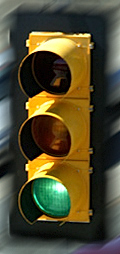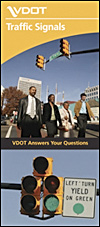Traffic Signals
VDOT explains traffic signals: audio  (MP3, 1.3 MB, 4:04), transcript
(MP3, 1.3 MB, 4:04), transcript  (PDF, 93 KB)
(PDF, 93 KB)
Frequently Asked Questions
How Does VDOT Decide When and Where To Install Traffic Signals?
Those red, yellow and green traffic signal lights are vital to controlling traffic in a safe and orderly manner.
They let motorists "take turns" moving through busy intersections and can enhance safety.
But, in the wrong location, a traffic signal can actually contribute to accidents and congestion.
A potential accident exists every time a vehicle is stopped on the highway.

Nearly every driver has experienced the anxiety of having a light suddenly turn yellow while rapidly approaching an intersection.
We all have been caught behind one red light after another on a busy thoroughfare.
The Virginia Department of Transportation's (VDOT) job is to find the point where a signal will help more than it will hinder traffic and relieve more congestion than it will cause.
In every case, VDOT's primary consideration is safety.
Purpose
Traffic signals are designed to:
- Ensure safe and orderly flow of traffic
- Protect pedestrians and vehicles at busy intersections
- Reduce the severity and frequency of accidents between vehicles entering intersections
How Does VDOT Decide Whether A Traffic Signal Should Be Installed?
The department follows federal guidelines that establish minimum conditions under which signal installation should be considered.
These guidelines help identify potential locations for signals, but each location is reviewed before a signal is installed.
Traffic engineers determine if a signal is needed by carefully evaluating:
- The number of vehicles and pedestrians that use the intersection
- The physical makeup of the intersection
- Roadside development
- Traffic delays during peak hours
- Average vehicle speeds
- Future road construction plans
- The number and types of accidents that have occurred there
What Are LED Traffic Signals?
New traffic lights you may see are made out of arrays of light emitting diodes (LEDs). These are tiny, purely electronic lights that are energy efficient and have a long life.
LEDs are replacing the old-style incandescent bulbs rated at 150 watts. The LED display has a 25 watt rating and generate very little heat, which cuts down on electricity demands.
Most cities in the United States are in the process of replacing their incandescent traffic lights with LED displays because they:
- Are brighter
- Last for years, while incandescent bulbs last for months
- Save a lot of energy and reduce operating costs
How Should Motorists Approach An Inoperative Traffic Signal?
Traffic signals may temporarily be affected with power outages or weather debris blocking view of the signal.
If you happen upon a traffic light experiencing an outage or covered by snow or debris, treat the traffic light as a stop sign and use extreme caution before proceeding.
Are Traffic Signals A Cure for Accidents?
Not in all cases.
Certain types of accidents can be reduced in number or severity by the installation of a signal, while other types may not be affected.
VDOT engineers generally recommend a traffic signal be installed when accidents involving vehicles approaching from different directions occur at an abnormally high rate.
But we only do this if a signal will improve safety and other remedies to prevent crashes don't work.
Rear-end collisions are not normally remedied by the installation of a signal.
Can Signals Contribute To Accidents And Congestion?
Definitely. Even though they are valuable tools, traffic signals are not a cure-all for every problem intersection.
A signal in the wrong location can contribute to:
- Rear-end collisions
- Excessive delays
- Unnecessary travel on alternate routes
- More congestion
How Do Traffic Signals Work?
There are two types of signals in Virginia: fixed time and traffic responsive.
Fixed-time traffic signals assign the green light to the different approaches of an intersection for a predetermined amount of time.
Some of them also can be set to change to different green times during peak traffic hours.
These signals can be found in urban areas where traffic movements are fairly predictable.

Traffic responsive signals change the lights according to the amount of traffic in each direction.
These signals use sensors to detect the number of vehicles.
They automatically adjust the length of the green light to allow as many vehicles as possible through an intersection before responding to vehicles on another approach.
How Often Are Traffic Signals Adjusted?
Our signals are connected to centralized computer systems.
These systems continuously monitor the status of the signals, collect traffic flow information and support signal-timing operations and changes, such as time of day and congestion levels.
Our system allows engineers to continually adjust the signals to respond to changing traffic patterns or accidents.
To download a brochure about traffic signal, click here. (PDF, 260 KB)
This information is not intended to replace the warrants and guidelines established by the federal Manual on Uniform Traffic Control Devices (MUTCD) and the Virginia supplement to the MUTCD.



